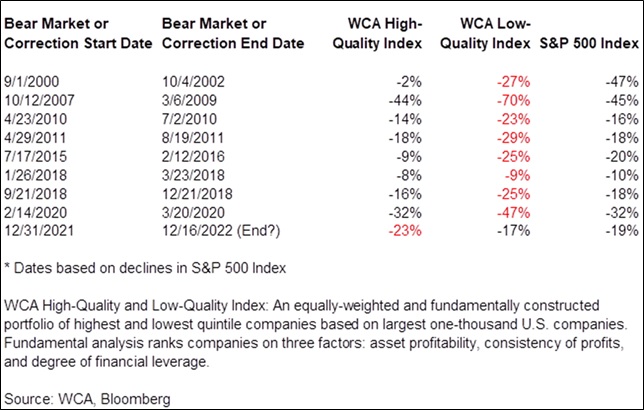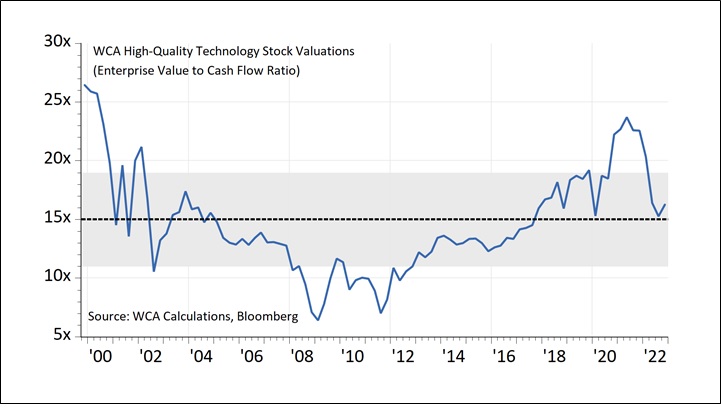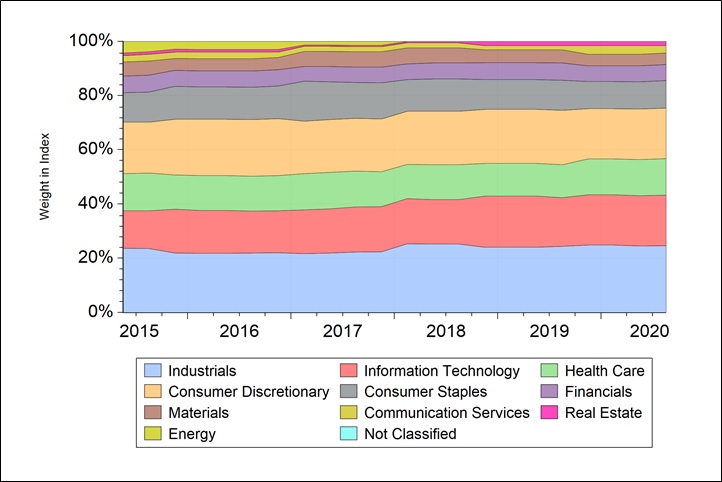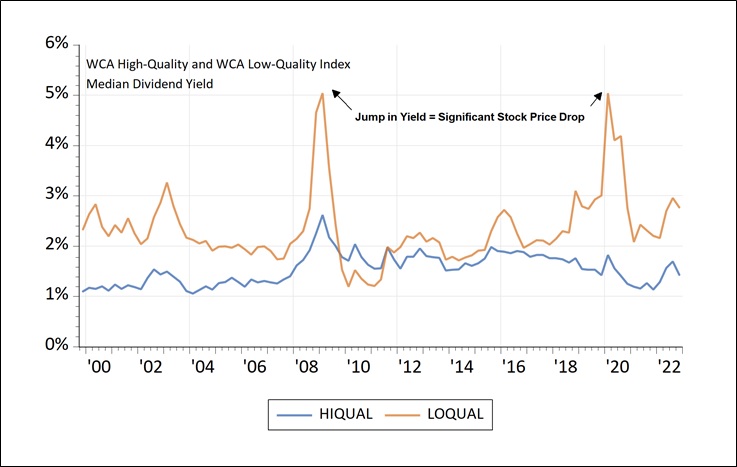Reexamining Quality
High-quality stocks beat low-quality stocks in every problematic market for the past twenty years, but not in 2022 (table below). In each bearish phase, high quality held up better than low. However, this was not the case this year. Year-to-date, the WCA High-Quality index is down 15%, while the WCA Low-Quality index is down just 5%. While this trend is changing with recent performance once again favoring high quality (more on this below), this year’s performance of high-and-low quality needs some examination.
High vs. Low-Quality Performance in Bad Markets
Before doing so, we remind readers that quality is important but just one aspect of good portfolio construction. We also care greatly about the price paid; otherwise, we just introduce risk by another route. And valuations were an obvious problem by the end of 2021. To understand why, please see these articles written in late 2021, where we described the issue in detail:
- Five Reasons for Caution (December 6, 2021)
- Beta Revisited (November 29, 2021)
- What Matters Most (November 23, 2021)
A year on, we now conclude that high valuations, mostly among technology names, are less of an issue. In addition, high quality is again outperforming, relative valuations are better, and attention is starting to shift to concerns about global growth.
How We Got Here: The ‘20-21 Flight to Quality
The shutdown and onset of the pandemic in 2020 ushered in a different way of life. Unprecedented stimulus collided with global supply shocks as society reorganized around remote work. To survive, the world turned to communication technology, distributed networks, and remote work. Earnings for the technology sector exploded, growing by more than 50% in 2021. Valuations for technology companies within our WCA High-Quality index soared to levels not seen since the tech bubble of 2000. At the peak in 2021, the total value of these firms, including debt, was 24 times cash flow — 60% above the 20-year average of 15 times (chart below).
Valuations Return to Earth for High-Quality Tech
With vaccinations rolled out and policy stimulus drying up, technology struggled in 2022. The technology-heavy Nasdaq Composite Index is down 31% for the year. Our WCA High-Quality index’s average high-quality tech stock is down 18% this year, in line with the market’s 19% decline. We describe these firms as “high quality” because they tend to have consistent and highly profitable assets with little or no debt. These characteristics make for more flexible, durable, and predictable businesses. All else being equal, the same elements can nurture sustainable growth and may point to a competitive “moat.”
All About Technology?
The preceding might lead us to think quality investing is all about technology, but we would be wrong to think that. In fact, our WCA High-Quality index, an equally-weighted index of consistent, profitable, low-debt businesses, is consistently dominated by a mix of industrials, technology, healthcare, and consumer companies (graph below).
A Sector View: WCA High-Quality Index
A recession or worsening financial market conditions would likely harm lower-quality, commodity-driven, or highly leveraged companies more. Sectors like these, notably energy and financials, depend more on commodity prices and financial engineering to generate returns. Conversely, higher-quality companies rely less on commodity prices and financial leverage, so they should show more flexibility and resilience in a recession.
Low Quality / High Yield
As the world contemplates recession, we are reminded of another significant relationship. Time and time again, we see that high dividend-yielding companies also tend to be low-quality. Moreover, these low-quality companies tend to get hurt the most when business conditions unexpectedly deteriorate.
Just look at the graph of dividend yields below. See that lower-quality companies usually come with higher dividend yields. But also notice how those yields soar in times of stress. This means that the prices of these stocks suffered more rapid and significant declines than those of higher-quality stocks under pressure. The adage, “you get what you pay for” comes to mind when buying dividend yield. High-yield stocks, like high-yield bonds, tend to go hand-in-hand with higher risk.
Yield Behavior: High-Quality vs. Low-Quality
Turning Point?
Changing leadership and better valuations for high-quality technology stocks suggest a turning point at hand. Since June, when the Treasury yield curve inverted (signaling higher recession odds), the WCA High-Quality index declined just 1%, while the WCA Low-Quality Index fell over 7%. We conclude that now is the time to reconsider high-quality in all its forms, including technology.
Ultimately, understanding the role of quality is critical for understanding risk. While high starting valuations did pose a challenge for many high-quality stocks in 2022 (i.e., high-quality technology), we now see this as a fading issue. We should be bold in pursuing high quality where valuations make sense. We will continue seeking the highest total return possible from companies we view most likely to generate the least amount of risk. Quality at the right price was, is, and always will be how we pursue this goal.
Kevin R. Caron, CFA
Senior Portfolio Manager
973-549-4051
Chad Morganlander
Senior Portfolio Manager
973-549-4052
Matthew Battipaglia
Portfolio Manager
973-549-4047
Steve Lerit, CFA
Senior Risk Manager
973-549-4028
Tom Serzan
Analyst
973-549-4335
Suzanne Ashley
Internal Relationship Manager
973-549-4168
Eric Needham
Director, External Sales and Marketing
312-771-6010
Jeffrey Battipaglia
Client Portfolio Manager
973-549-4031
Disclosures
The information contained herein has been prepared from sources believed to be reliable but is not guaranteed by us and is not a complete summary or statement of all available data, nor is it considered an offer to buy or sell any securities referred to herein. Opinions expressed are subject to change without notice and do not take into account the particular investment objectives, financial situation, or needs of individual investors. There is no guarantee that the figures or opinions forecast in this report will be realized or achieved. Employees of Stifel, Nicolaus & Company, Incorporated or its affiliates may, at times, release written or oral commentary, technical analysis, or trading strategies that differ from the opinions expressed within. Past performance is no guarantee of future results. Indices are unmanaged, and you cannot invest directly in an index.
Asset allocation and diversification do not ensure a profit and may not protect against loss. There are special considerations associated with international investing, including the risk of currency fluctuations and political and economic events. Changes in market conditions or a company’s financial condition may impact a company’s ability to continue to pay dividends, and companies may also choose to discontinue dividend payments. Investing in emerging markets may involve greater risk and volatility than investing in more developed countries. Due to their narrow focus, sector-based investments typically exhibit greater volatility. Small-company stocks are typically more volatile and carry additional risks since smaller companies generally are not as well established as larger companies. Property values can fall due to environmental, economic, or other reasons, and changes in interest rates can negatively impact the performance of real estate companies. When investing in bonds, it is important to note that as interest rates rise, bond prices will fall. High-yield bonds have greater credit risk than higher-quality bonds. Bond laddering does not assure a profit or protect against loss in a declining market. The risk of loss in trading commodities and futures can be substantial. You should therefore carefully consider whether such trading is suitable for you in light of your financial condition. The high degree of leverage that is often obtainable in commodity trading can work against you as well as for you. The use of leverage can lead to large losses as well as gains. Changes in market conditions or a company’s financial condition may impact a company’s ability to continue to pay dividends, and companies may also choose to discontinue dividend payments.
All investments involve risk, including loss of principal, and there is no guarantee that investment objectives will be met. It is important to review your investment objectives, risk tolerance, and liquidity needs before choosing an investment style or manager. Equity investments are subject generally to market, market sector, market liquidity, issuer, and investment style risks, among other factors to varying degrees. Fixed Income investments are subject to market, market liquidity, issuer, investment style, interest rate, credit quality, and call risks, among other factors to varying degrees.
This commentary often expresses opinions about the direction of market, investment sector, and other trends. The opinions should not be considered predictions of future results. The information contained in this report is based on sources believed to be reliable, but is not guaranteed and not necessarily complete.
The securities discussed in this material were selected due to recent changes in the strategies. This selection criterion is not based on any measurement of performance of the underlying security.
Washington Crossing Advisors, LLC is a wholly-owned subsidiary and affiliated SEC Registered Investment Adviser of Stifel Financial Corp (NYSE: SF). Registration with the SEC implies no level of sophistication in investment management.







